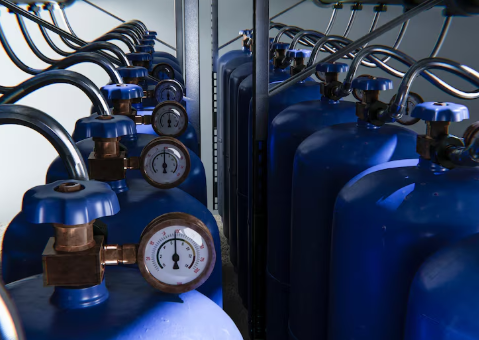As the evenings turn cooler, nothing keeps your outdoor gatherings comfortable like a patio heater. Whether you’re hosting a small dinner, enjoying a quiet night under the stars, or keeping your café terrace warm, a reliable patio heater makes all the difference. But sooner or later, every patio heater owner faces the same question — how do you refill gas bottles safely and correctly?
If you’re new to using propane or butane gas bottles, this guide will walk you through everything you need to know — from understanding your gas type to refilling, handling, and maintaining your bottles safely. Let’s get started.
Understanding Your Patio Heater’s Gas Bottle
Before you even think about refilling, it’s essential to understand what kind of gas your patio heater uses. Most patio heaters run on liquefied petroleum gas (LPG) — either propane or butane. These gases are stored in pressurized bottles (also called cylinders), which fuel the heater through a regulator and hose system.
Propane vs. Butane
-
Propane is ideal for outdoor use and performs well even in cold weather. If you use your patio heater during winter or in cooler climates, propane is usually the best choice.
-
Butane, on the other hand, is more suited for mild or warm climates. It offers slightly more energy per unit but doesn’t vaporize well in low temperatures.
Your patio heater’s user manual or label should indicate which gas type it requires. Using the correct gas is crucial for safety and efficiency.
When Should You Refill Your Gas Bottle?
The first sign that you need a refill is when your patio heater starts to lose heat output or fails to ignite. Here are a few ways to check your gas level before refilling:
-
Weight Check:
Most gas bottles have their empty weight (called the tare weight) stamped on the neck or handle. Subtract that from the total weight to estimate how much gas is left. -
Warm Water Test:
Pour warm (not boiling) water down the side of the bottle. Wait a few seconds, then feel the metal with your hand. The section that feels cool indicates the current gas level. -
Gas Level Indicator:
You can also buy an inexpensive gas level gauge or magnetic indicator that attaches to the bottle.
Knowing when to refill helps you avoid running out of gas mid-gathering — and ensures your heater works smoothly whenever you need it.
Options for Refilling Gas Bottles
When your gas bottle runs low, you have two main options:
-
Refilling Your Existing Gas Bottle
-
Exchanging Your Empty Bottle for a Full One
Let’s look at each in detail.
1. Refilling Your Existing Bottle
Some suppliers allow you to bring in your empty gas bottle and have it refilled on-site. This is often the most cost-effective method. The station will connect your bottle to a large LPG storage tank and refill it safely for you.
However, not all bottles can be refilled, especially if they belong to specific brands that operate on an exchange system. Always check the brand’s policy — for example, some cylinders are “non-refillable” and must be swapped instead.
2. Bottle Exchange Service
If refilling isn’t available, many retailers and gas suppliers offer an exchange program. You bring your empty gas bottle, pay for the gas (and sometimes a small service fee), and receive a pre-filled, safety-tested bottle in return.
This option is convenient, widely available, and ensures that every bottle you receive has been inspected for leaks and regulatory compliance.
Safety Precautions Before Refilling Gas Bottles
Handling LPG cylinders requires care and attention. Before refilling, make sure to follow these safety steps:
-
Check for Damage:
Inspect the bottle for dents, rust, cracks, or other damage. Never refill a damaged cylinder — it could leak or rupture. -
Ensure Proper Ventilation:
Always refill gas bottles outdoors or in a well-ventilated area. LPG vapors are heavier than air and can collect in low spaces, posing explosion risks. -
No Smoking or Open Flames:
Keep all flames, cigarettes, and electrical sparks far away from the refilling area. -
Use Correct Equipment:
Only use certified hoses, adapters, and regulators designed for LPG. Makeshift connections can be extremely dangerous. -
Wear Protective Gear:
Gloves and safety glasses are recommended, especially when handling cold metal surfaces or pressurized gas.
Step-by-Step: How to Refill Gas Bottles for Your Patio Heater
While most homeowners prefer professional refills, some experienced users refill their own smaller bottles using a refill adapter and a larger gas tank. If you choose to do this yourself, proceed with extreme caution and follow every step carefully.
Note: Always check your local laws and safety regulations. In some regions, self-refilling LPG bottles is restricted or requires certification.
Step 1: Gather Your Equipment
You’ll need:
-
An empty gas bottle (the one you’re refilling)
-
A full donor LPG tank (same gas type)
-
A refill adapter or transfer valve (compatible with both bottles)
-
A digital scale (optional, for weight monitoring)
-
Protective gloves
Step 2: Place Both Bottles on a Stable Surface
Ensure both cylinders are upright on a stable, non-flammable surface outdoors. The full donor bottle should be slightly higher than the empty one for gravity-assisted transfer.
Step 3: Connect the Adapter
Attach the refill adapter between the two bottles — the full tank’s valve connects to the adapter’s input, and the empty bottle’s valve connects to the output. Tighten securely to prevent leaks.
Step 4: Open the Valves
-
Open the valve on the donor bottle slowly.
-
Then open the valve on the receiving bottle.
You’ll hear a faint hiss as the gas begins to transfer.
Allow the process to continue until you feel the transfer slow down or stop. This usually takes a few minutes.
Step 5: Close the Valves
Once the transfer is complete, close both valves tightly. Disconnect the adapter carefully.
Step 6: Check for Leaks
Before using the bottle, check for leaks using a soapy water test:
-
Mix water with a few drops of dish soap.
-
Apply the solution around the valve and connections.
-
If you see bubbles forming, there’s a leak. Tighten fittings or replace faulty parts before use.
Proper Storage and Handling After Refilling
After refilling your gas bottle, storing it safely is just as important as filling it correctly. Follow these storage tips to ensure safety and longevity:
-
Keep Upright:
Always store gas bottles in an upright position to prevent liquid gas from leaking. -
Ventilated Space:
Store bottles outdoors or in a well-ventilated shed — never in basements or enclosed areas. -
Avoid Direct Sunlight:
Keep bottles away from direct heat or sunlight to prevent pressure buildup. -
Cap the Valve:
If you’re not using the bottle immediately, close the valve tightly and use the protective cap or plug. -
Distance from Ignition Sources:
Keep bottles at least 3 meters away from open flames, electrical appliances, or anything that could spark.
Connecting the Refilled Bottle to Your Patio Heater
Once your gas bottle is full, connecting it to your patio heater is straightforward — but still requires attention to safety.
-
Turn Off Everything:
Make sure the patio heater’s control knob and gas supply valve are both turned off. -
Attach the Regulator:
Secure the regulator to the gas bottle’s valve, ensuring a snug, leak-free fit. Some systems have a “click-on” mechanism, while others use a threaded connection. -
Check for Leaks Again:
Perform another soapy water test after connection. No bubbles mean it’s safe to ignite. -
Ignite the Heater:
Turn on the gas supply and ignite your heater following the manufacturer’s instructions. You should see a steady flame within seconds.
Common Mistakes to Avoid When Refilling Gas Bottles
Even seasoned users can make errors when refilling or handling LPG bottles. Avoid these common pitfalls:
-
Overfilling the Bottle:
Overfilling can cause liquid gas to leak, especially in warm weather when pressure increases. Always leave some space for gas expansion. -
Mixing Gas Types:
Never mix propane and butane — each requires specific regulators and pressures. -
Ignoring Expiry Dates:
Gas bottles have a test or expiry date (often stamped near the collar). Don’t refill expired cylinders — get them tested or exchanged. -
Storing Indoors:
Gas bottles should never be kept inside your home, garage, or any enclosed space. -
Using Damaged Equipment:
Replace worn-out hoses, regulators, and seals immediately to prevent leaks.
Environmental and Cost Benefits of Refilling Gas Bottles
Refilling gas bottles isn’t just practical — it’s also environmentally friendly and economical.
-
Less Waste:
Reusing gas bottles reduces metal waste and energy used in manufacturing new cylinders. -
Lower Costs:
Refilling is typically cheaper than exchanging, saving you money over time. -
Sustainable Heating:
LPG burns cleaner than many other fuels, producing fewer greenhouse gases and less soot.
By maintaining and refilling your bottles responsibly, you contribute to both environmental protection and household efficiency.
Troubleshooting: What to Do if Your Heater Won’t Work After Refilling
If your patio heater doesn’t light or stay on after refilling, try these quick checks:
-
Check the Regulator and Hose:
Make sure connections are tight and the regulator is functioning properly. -
Purge Air from the Line:
Air may get trapped in the hose after refilling. Turn on the gas for a few seconds before igniting to allow the air to escape. -
Inspect for Ice Formation:
If the bottle is too cold, pressure can drop. Allow it to warm slightly before retrying. -
Ensure the Gas Type Matches:
Double-check that the gas in your refilled bottle is the correct type for your heater.
If problems persist, it’s best to consult a professional technician rather than trying to repair or modify the equipment yourself.
Conclusion
Refill gas bottles for your patio heater may seem intimidating at first, but with the right knowledge and safety precautions, it’s a simple and rewarding task. Understanding your gas type, following step-by-step refilling procedures, and maintaining your equipment properly will ensure that your patio heater runs efficiently for years to come.
Whether you choose to refill your bottle yourself or use a professional service, always prioritize safety and compliance. A well-maintained gas bottle not only keeps your patio heater performing at its best but also gives you peace of mind — allowing you to relax and enjoy warm, cozy evenings outdoors, no matter the season.



